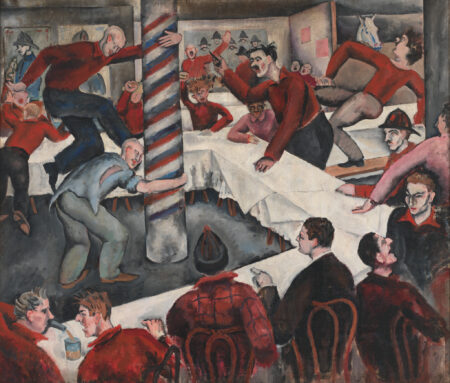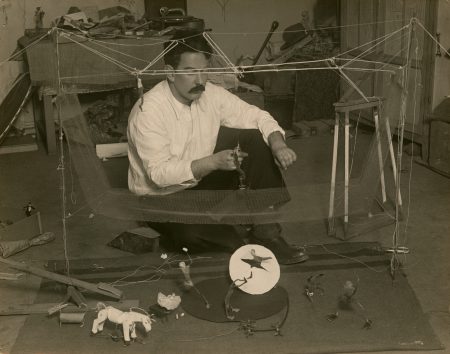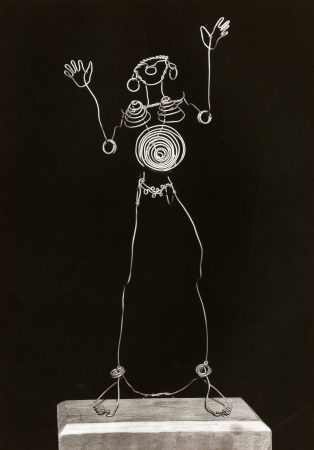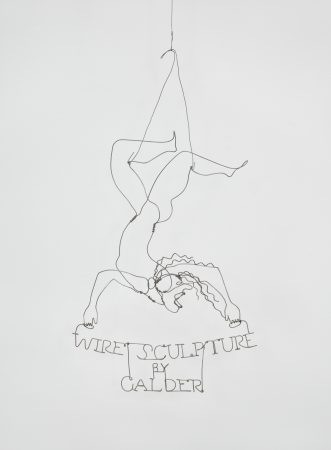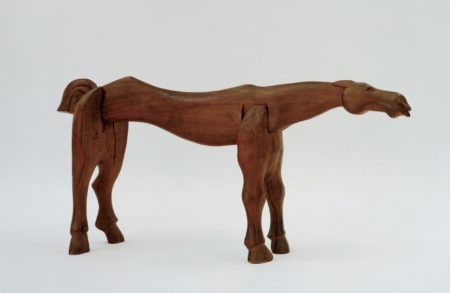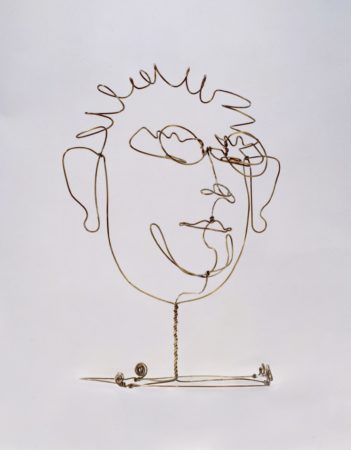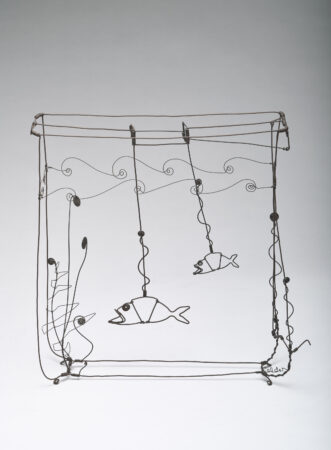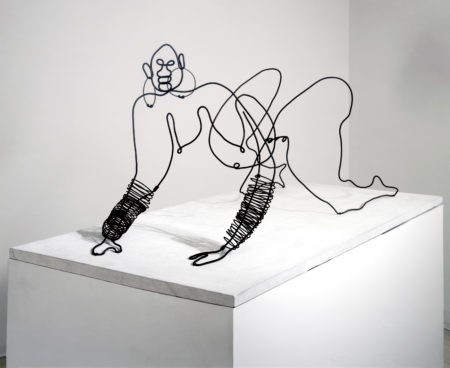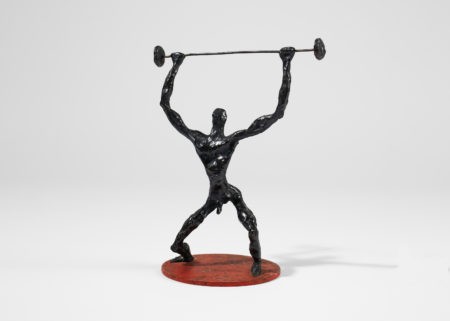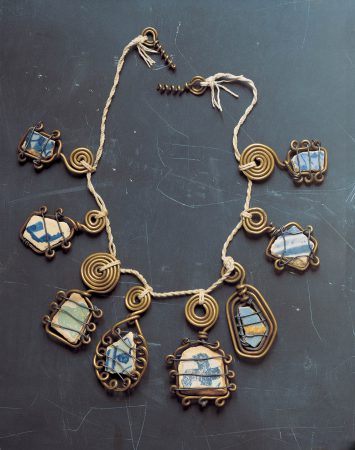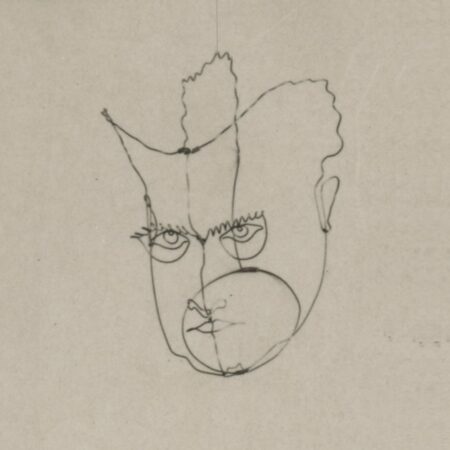Archive
See highlights from 1926–1930 on the timeline Wire Sculpture and the Circus
Artists Gallery, New York, includes an oil painting by Calder in a group exhibition. Murdock Pemberton, the art critic for the New Yorker, comments on the exhibition: A. Calder, too, we think is a good bet.
CF, exhibition file; Pemberton 1926While renting a room in the apartment of Alexander Brook, assistant director of the Whitney Studio Club, Calder embellishes the Brook children’s “Humpty Dumpty Circus.” He adds movement and articulation to the set of store-bought toys, making an elephant that could “go round
a circle” and a mechanism that could “hoist a clown on his back.”
American painter Walter Kuhn organizes a stag dinner at the Union Square Volunteer Fire Brigade, Tip Toe Inn, New York, in honor of sculptor Constantin Brancusi’s first visit to the United States. Calder paints Firemen’s Dinner for Brancusi commemorating the event.
Geist 1976; AAA, Louis Bouché Papers, dinner invitation; CF, object fileCalder sketches a human dissection at Physicians and Surgeons Hospital. I drew for several hours and subsequently painted The Stiff . . . I went to a party that evening and kept asking if I did not smell of forma(h)ldehide—my hair, particularly. They said “no”—but
the odor was with me—and although I really intended returning, I never did.
Calder exhibits The Stiff in the Tenth Annual Exhibition of the Society of Independent Artists at the Waldorf-Astoria, New York.
CF, exhibition fileCalder exhibits an oil painting at the Whitney Studio Club Eleventh Annual Exhibition of Paintings and Sculpture by Members of the Club, Anderson Galleries, New York.
CF, exhibition fileAt his friend Betty Salemme’s house on Candlewood Lake in Sherman, Connecticut, Calder carves his first wood sculpture, Very Flat Cat, from an oak fence post.
CF, Calder 1955–56, 174Calder moves into a tiny, one-room apartment at 249 West Fourteenth Street. There he makes his first wire sculpture, a sundial in the form of a “rooster on a vertical rod with radiating lines at the foot” to demarcate the hours.
Hayes 1977, 90; Calder 1966, 71–72Animal Sketching, a drawing manual written by Calder with reproductions of 141 of his brush drawings, is published by Bridgman Publishers in New York and The Bodley Head in London.
CF, project fileCalder exhibits The Horse Show in an exhibition on the subject of the horse at the Anderson Galleries, New York, curated by Karl Freund.
CF, exhibition fileCalder receives his U.S. passport in preparation for his first voyage to Europe.
CF, passport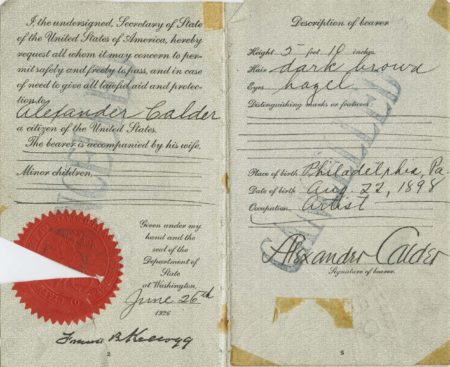
With the help of his former teacher, Clinton Balmer, Calder signs on to the crew of the Galileo, a British freighter sailing for Hull, England. He works as a laborer, painting the exterior of the ship.
Calder 1966, 76–77; CF, Calder to parents, 18 JulyCalder arrives in Hull, spends one night, and takes the noon train to London.
CF, Calder to parents, 18 JulyCalder arrives in London and stays four nights with Bob Trube, his fraternity brother from Stevens.
CF, Calder to parents, 26 JulyCalder leaves England, taking the 10 a.m. train from Victoria Station to New Haven and the ferry to Ville de Dieppe in France. He arrives in Paris and calls on Trube’s father at the Hôtel de Versailles, 60 boulevard de Montparnasse. [Trube] had written his dad to look out for
me. So I got a room here at 35F and am on the 7th floor with a French window that gives fine light and air and a red rug and brown wallpaper that would knock your eye out. Also an upright piano.
At the Café du Dôme, a meeting place for artists and their dealers, Calder recognizes American painter Arthur Frank, an acquaintance from New York, and meets British printmaker Stanley William Hayter, whose wife he knew from the Art Students League.
Calder 1966, 78Calder enrolls in drawing classes at the Académie de la Grande Chaumière.
Calder 1966, 78Calder’s French identity card is issued for 1926–27.
CF, carte d'identité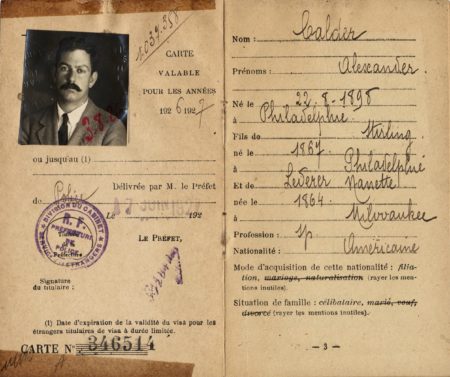
Calder establishes a studio at 22 rue Daguerre.
CF, Calder to parents, c. 26 AugustCalder is hired to leave France for a quick round-trip voyage on the SS Volendam Holland America Line; he sketches life on board the ship for the Student Third Cabin Association’s poster and advertising brochure.
Calder 1966, 79; CF, Calder to parents, 26 AugustCalder arrives in New York on the SS Volendam.
CF, Calder to parents, c. 26 AugustCalder arrives at Boulogne-sur-Mer, France, on the SS Volendam.
CF, Calder to parents, 25 and 27 SeptemberCalder travels by train to Paris from Boulogne-sur-Mer.
CF, Calder to parents, OctoberCalder meets Lloyd Sloane, an advertising executive, who introduces him to staff at Le Boulevardier, including Marc Réal, artistic advisor. Several of Calder’s drawings are published in Le Boulevardier over the next few months.
Calder 1966, 83Calder meets a Serbian toy merchant who encourages him to make mechanical toys for mass production.
Calder 1966, 80; CF, Calder 1955–56, 44Through Hayter, Calder meets José de Creeft, a Spanish sculptor living on rue Broca. De Creeft suggests to Calder that he submit his toys to the “Salon des Humoristes.”
Calder 1966, 80Calder begins creating Cirque Calder, a complex and unique body of art. Fashioned from wire, fabric, leather, rubber, cork, and other materials, Cirque Calder is designed to be performed for an audience by Calder. It develops into a multi-act articulated series of mechanized sculpture in miniature scale, a distillation of the natural circus.
Calder is able to travel with his easily transportable circus and hold performances on both continents. Over the next five years, Calder continues to develop and expand this work of performance art to fill five large suitcases.
Calder makes his first formal wire sculptures, Josephine Baker I and Struttin’ His Stuff.
Calder 1966, 80–81; CF, Calder 1955–56, 45Calder performs Cirque Calder for Mrs. Frances C. L. Robbins, a patron of young artists. On her recommendation, English novelist Mary Butts comes to see it and in turn sends Jean Cocteau to a performance.
CF, Calder 1955–56, 68; Hawes 19281927
Calder exhibits toys in the “Salon des Humoristes” at Galerie de la Boétie, Paris.
CF, exhibition fileRéal brings Guy Selz and the circus critic, Legrand-Chabrier, to see Calder perform Cirque Calder. Legrand-Chabrier admires Calder’s work and writes several articles on the Cirque. Oh, these are stylized silhouettes, but astonishing in their miniature resemblance,
obtained by means of luck, iron wire, spools, corks, elastics . . . A stroke of the brush, a stroke of the knife, of this, of that; these are the skillful marks that reconstruct the individuals that we see at the circus.
Here is a dog who seems like a prehistoric cave drawing with a body of iron wire. He will jump through a paper hoop. Yes, but he may miss his mark or not. This is not a mechanical toy . . .
All of this is arranged and balanced according to the laws of physics in action so that it allows for the miracles of circus acrobatics.
Calder renews his French identity card.
CF, carte d'identitéGalleries of Jacques Seligmann and Company, Paris, exhibits animated toys by Calder.
CF, exhibition file; Comoedia, 29 AugustThe New York Herald, Paris, publishes an article about Calder and his decision to make toys: I began by futuristic painting in a small studio in the Greenwich Village section of New York. It was a lot different to engineering but I took to my newfound art immediately. But it seemed that
during all of this time I could never forget my training at Stevens, for I started experimenting with toys in a mechanical way. I could not experiment with mechanism as it was too expensive and too bulky so I built miniature instruments. From that the toy idea suggested itself to me so I figured I might as well turn my efforts to something that would bring remuneration. From then on I have constructed several thousand workable toys.
Calder returns to New York and stays with his parents at 9 East Eighth Street.
CF, Calder 1955–56, 46; Calder 1966, 86Calder travels to Oshkosh, Wisconsin, to contract with Gould Manufacturing Company. He designs prototypes for a series of plywood animal Action Toys.
Calder 1966, 83–85; CF, Pajeau to Calder, 12 NovemberCalder returns to New York and rents a room at 46 Charles Street where he gives Cirque Calder performances.
Calder 1966, 87; CF, Calder 1955–56, 461928
Weyhe Gallery, New York, exhibits “Wire Sculpture by Alexander Calder.” Calder creates a hanging sign, Wire Sculpture by Alexander Calder, for the gallery window. Pioneer Woman is sold to Marie Sterner, an art dealer.
CF, exhibition file; CF, Calder 1955–56, 25Calder exhibits four sculptures, including Romulus and Remus and Spring, in the Twelfth Annual Exhibition of the Society of Independent Artists at the Waldorf-Astoria, New York.
CF, exhibition file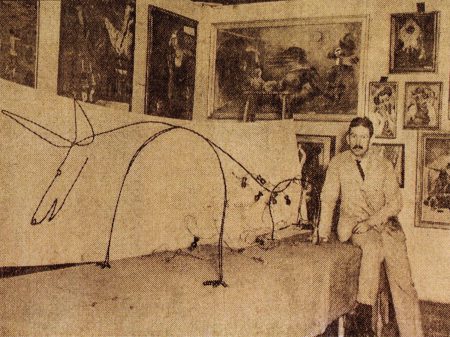
ACME Film Company produces Sculptor Discards Clay to Ply His Art in Wire, a film of Calder’s wire sculpture that includes footage of Calder creating a wire portrait of Elizabeth “Babe” Hawes, a reporter and aspiring fashion designer whom he had met in Paris.
CF, project file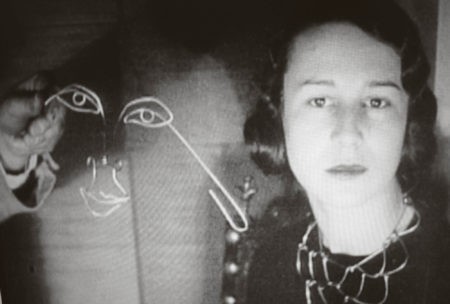
Calder spends the summer working on wood and wire sculptures at the Peekskill, New York, farm of J. L. Murphy, the uncle of fraternity brother Bill Drew. I worked outside on an upturned water trough and carved the wooden horse bought later by the Museum of
Modern Art, a cow, a giraffe, a camel, two elephants, another cat, several circus figures, a man with a hollow chest, and an ebony lady bending over dangerously, whom I daringly called Liquorice.
Hawes establishes a couture house at West Fifty-sixth Street in New York. Calder occasionally designs neckpieces and other accessories for her clothing.
Hawes 1938, 134–36; Berch 1988, 34–35The French Consulate, New York, grants Calder a visa.
AAA, passportCalder arrives at Le Havre after a voyage from New York on the De Grasse. He returns to Paris, where he rents a small building behind 7 rue Cels to use as his studio. When I returned to Paris in Nov. 28 I was a “wire sculptor” as I put it, also “le roi du fil de fer.”
AAA, passport; Calder 1966, 91; CF, Calder 1955–56, 49At the Café du Dôme, Paris, Calder sees his acquaintance, painter Yasuo Kuniyoshi, and meets “a small man in a bowler hat,” who he learns is painter Jules Pascin, a friend of Stirling’s.
Calder 1966, 91At the recommendation of Hawes, Calder writes to Joan Miró in Montroig, Spain, suggesting that they meet when Miró returns to Paris.
Calder 1966, 92; FJM, Calder to Miró, 10 December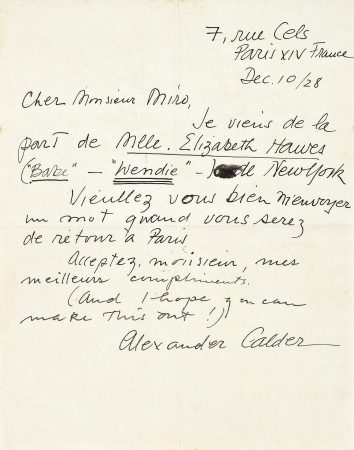
Calder visits Miró at his Montmartre studio, a sort of metal tunnel, a kind of Quonset hut. Miró has no paintings in the studio, but he shows Calder a collage, a big sheet of heavy gray cardboard with a feather, a cork, and a picture postcard glued to it. There were probably a few
dotted lines . . . I was nonplussed; it did not look like art to me. Later, Miró attends Cirque Calder at Calder’s rue Cels studio. Miró says, “I liked the bits of paper best.” These are little bits of white paper, with a hole and slight weight on each one, which flutter down several variously coiled thin steel wires, which I jiggle so that they flutter down like doves onto the shoulder of a bejeweled circus belle dame.
1929
Calder exhibits Romulus and Remus and Spring at the Salon de la Société des Artistes Indépendants, Paris. The public reaction is a mixture of confusion and delight. One critic remarks, At first, I believed that electricians had forgotten their electrical wire in this room, but
as I passed, a wire became agitated and I noticed that it represented the head of a she-wolf. Another tangle of electrical wire represented, by all evidence, a giant young woman. Another critic advises, All the same, look at them. Who knows if the sculpture of Mr. Calder is not that of the future? In any case, it doesn’t spawn melancholy.
In writing about his own history of wire sculpting, Calder notes a change in his approach to the medium: Before, the wire studies were subjective, portraits, caricatures, stylized representations of beasts and humans. But these recent things have been viewed from a more
objective angle and although their present size is diminutive, I feel that there is no limitation to the scale to which they can be enlarged . . . There is one thing, in particular, which connects them with history. One of the canons of the futuristic painters, as propounded by Modigliani, was that objects behind other objects should not be lost to view, but should be shown through the others by making the latter transparent. The wire sculpture accomplishes this in a most decided manner.
Galerie Billiet-Pierre Vorms, Paris, exhibits “Sculptures bois et fil de fer de Alexandre Calder.” Pascin writes the preface for the exhibition catalogue:
By some miracle, I became a member of a group of Aces of American Art, a Society of very successful painters and
sculptors!!!
—The fortunes of the life of an itinerant painter!
The same luck led me to meet the father Stirling Calder.
Away from New York at the time of our exhibition, I cannot testify to the success of our effort; but in any case, I can attest that Mr. Stirling Calder, who is one of our best American sculptors, is also the handsomest man in our Group.
Returning to Paris, I met his son SANDY CALDER, who at first sight left me quite disillusioned. He is less handsome than his Dad! Honestly!!!
But in the presence of his works, I know that he will soon make his mark; and that despite his appearance, he will exhibit with spectacular success alongside his Dad and other great artists like me, PASCIN, who’s talking to you . . . !
In a review of Calder’s solo show at Galerie Billiet-Pierre Vorms, Paris, the phrase “drawing in space” is coined to describe Calder’s wire sculptures. Horses rear up, riders brace themselves, dancers throw to the sky legs more rigid than doorbell wires. It looks like a drawing in space. On
the following day, Paul Fierens uses the phrase to describe Romulus and Remus and Spring at the Salon de la Société des Artistes Indépendants, Paris.
Weyhe Gallery, New York, exhibits “Wood Carvings by Alexander Calder.” Calder writes to his parents about their thoughts on the exhibition. I’m glad you think the show looked well, for I was afraid they would clutter it up and detract from things.
CF, exhibition file; CF, Calder to parents, 5 March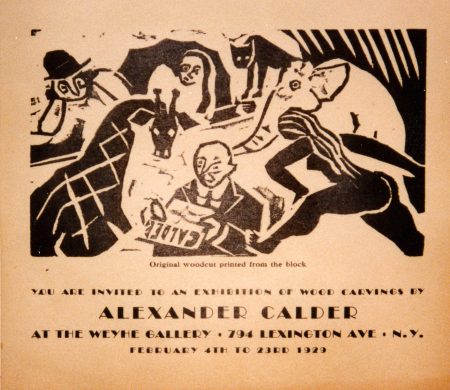
Sacha Stone, a German photographer, sees Calder perform Cirque Calder at the rue Cels studio. He suggests that Calder perform and exhibit in Berlin.
Calder 1966, 97The German Consulate, Paris, stamps Calder’s passport.
AAA, passportCalder leaves Paris with Stone and takes a train to Berlin to make arrangements for an exhibition.
CF, Calder to parents, 17 MarchCalder returns to Paris to gather works to exhibit in Berlin.
CF, Calder to parents, 6 AprilCalder travels back to Berlin to prepare his exhibition.
CF, Calder to parents, 6 AprilGalerie Neumann-Nierendorf, Berlin, presents “Alexander Calder: Skulpturen aus Holz und aus Draht.” Chantal Quenneville Hallis a French paintrix was there and I made a wire fly dangling from a beam attached to a collar. That was about my first jewelry.
Calder 1966, 98–99; CF, Calder 1955–56, 50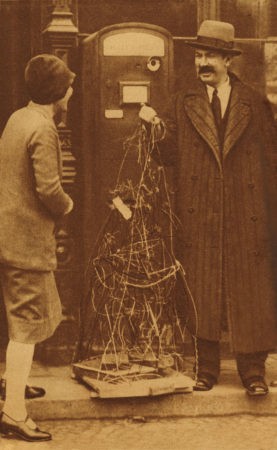
In Berlin, Dr. Hans Cürlis directs a short film of Calder creating Two Acrobats as part of the series Artists at Work. Calder makes a wire portrait of Cürlis.
CF, Calder to parents, before 8 MayI have had 2 large circus parties since coming back to Paris. At one of them we had Paul Fratellini, one of the famous clowns at the Cirque d’Hiver. It was quite a swell party—and I am making one of the toys in a size large enough for him to use in the Cirque d’Hiver.
CF, Calder to parents, before 8 MayCalder exhibits a wire sculpture at the Salon des Tuileries, Paris.
CF, exhibition filePathé Cinema, Paris, produces a short film of Calder at work in his rue Cels studio. Calder invites Kiki de Montparnasse to model for a wire portrait during the filming.
Calder 1966, 99; New York Herald [Paris edition], 21 May; HRC, Calder to Roché, 10 May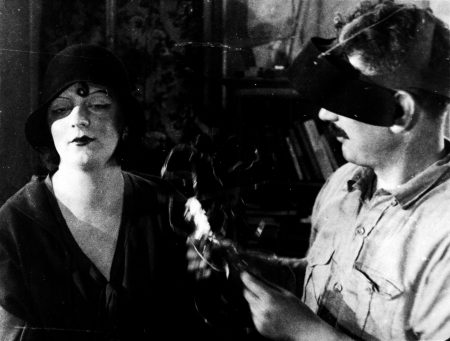
André Kertész photographs Calder at his rue Cels studio.
CF, photography file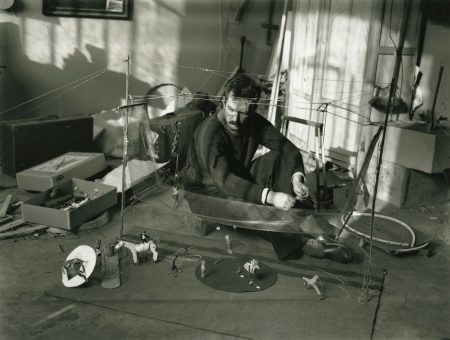
Calder performs Cirque Calder in the studio of Tsuguharu Foujita, a painter and well-known denizen of Montparnasse. Foujita plays a drum to accompany Calder’s performance. Man Ray and Kiki are among the guests in attendance.
HRC, Calder to Roché; Illustrirte Zeitung, 29 AugustCalder embarks for New York on the De Grasse, bringing Cirque Calder with him. During the voyage, he meets Edward Holton James and his daughter Louisa. So once on board the De Grasse, I started walking the deck. I overtook an elderly man and a young lady. I could only see them
from the back, so I reversed my steps the better to see them face on. Upon coming abreast of them the next time around, I said, “Good evening!” And the man said to his daughter, “There is one of them already!” He was Edward Holton James, my future father-in-law. She was Louisa. Her father had just taken her to Europe to mix with the young intellectual elite. All she met were concierges, doormen, cab drivers—and finally me.
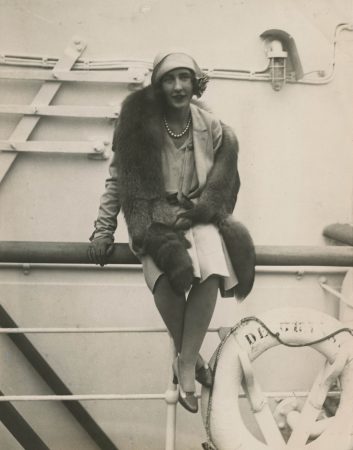
Calder occupies his father’s studio on 11 East Fourteenth Street. He visits his family in Pittsfield, Massachusetts.
Calder 1966, 101–2Calder visits Louisa and her older sister, Mary, at Eastham on Cape Cod. Calder was a perfect guest. He mended everything in sight and kept us in gales of laughter all day long.
Calder 1966, 101; CF, Louisa to mother, 29 AugustCalder performs Cirque Calder at Hawes’s couture house, 8 West Fifty-sixth Street, New York.
AAA, circus posterCalder performs Cirque Calder at art patron Mildred Harbeck’s apartment, 306 Lexington Avenue, New York.
AAA, circus posterCalder stays with his friend, book designer Robert Josephy, at Beekman Place and Fiftieth Street. Josephy was very enthusiastic over my circus. This encouraged me and while at his house, I worked on it very hard. He helped me. We made the chariot race and the lion tamer,
and it got to be quite a full blown circus, growing from two suitcases into five.
After the New Yorker announces that performances of Cirque Calder can be arranged through the Junior League Entertainment Center at Saks Fifth Avenue, Calder is hired by Newbold Morris to perform in his Babylon, Long Island, home; Isamu Noguchi operates a phonograph providing the music.
"Sudden Brain Waves," 1929; CF, Calder 1955–56, 142Fifty-Sixth Street Galleries, New York, exhibits “Alexander Calder: Paintings, Wood Sculpture, Toys, Wire Sculpture, Jewelry, Textiles.” Calder performs Cirque Calder at the show’s vernissage on 1 December.
CF, exhibition fileFor her birthday, Calder gives Hawes a wire “chastity belt” that spells out her name along with the French café slogan “ouvert la nuit” (open at night).
Hawes 1938, 136; Berch 1988, 34–35Calder creates his first formal mechanized sculpture, Goldfish Bowl, and presents it to his mother as a Christmas gift. For his father, he makes a brass wire fish. In a letter to Peggy, Nanette writes, He made me a fish tank of brass wire, with two fish that wiggle as you turn a crank made
also of wire. Waves are indicated along the top. For your Dad a large fish that is now hanging from the electric light. Peggy, it is remarkable. One wire beginning at his tail, running along the backbone to the head where the eyes and mouth are faultlessly placed. Then the wire loops around the back bone as it travels back to form the other half of the tail. This is hard to describe, but it is really wonderful as is the fish bowl in which the fishes bend as tho [sic] swimming.
Calder performs Cirque Calder in the home of Aline Bernstein on Park Avenue. Noguchi is present, as is Thomas Wolfe, who later incorporates a wry fictionalized account of the event into his novel, You Can’t Go Home Again.
Calder 1966, 106–107; Hayes 1977, 226At a party thrown by Walter Damrosch at NBC Studios, Calder approaches Aline Fruhauf, the cartoonist for the magazine Top Notes. He was a nice young man, quiety mirthful, distinguished from among the other white shirt-fronted gentlemen of the party by a
curiously wrought ornament which seemed to be a bee or dragonfly of gold filament, perched where a shirt stud should be. Suddenly, he reached in his pocket, brought out a paper and a pencil and began to caricature the cartoonist.
Calder performs Cirque Calder on New Year’s Eve at the home of Jack and Edith Straus on West Fifty-seventh Street, New York.
CF, Calder 1955–56, 1421930
Two works by Calder are exhibited at the Salon de la Société des Artistes Indépendants, Paris.
CF, exhibition fileCalder stays in the apartment of his friend Paul Nitze at 112 East Fortieth Street. At Nitze’s request, he performs Cirque Calder.
Calder 1966, 107; CF, Calder 1955–56, 110Harvard Society for Contemporary Art, Cambridge, Massachusetts, exhibits “Wire Sculpture by Alexander Calder.” Calder performs Cirque Calder for the faculty and students on 31 January.
CF, exhibition fileCalder performs Cirque Calder at artist Margarett Sargent’s house, 205 Commonwealth Avenue, Boston.
Calder sails for Spain on the Spanish freighter Motomar. The ship docks briefly in Málaga and Calder explores the town. Two days later, Calder debarks in Barcelona. I went to the Hotel Regina, in a little room up somewhere high. It was then I decided that I liked white walls
and red tile flooring . . . I tried to find Miró, but I guess he was away in the country. I went to a bullfight, and then on to Paris by train.
Calder rents a studio at 7 Villa Brune.
Calder 1966, 110Calder exhibits La Negresse in “11e Salon de l’Araignée” at Galerie G. L. Manuel Frères, Paris.
CF, exhibition fileCalder makes thirteen plaster sculptures and casts eight of them in bronze at the Fonderie Valsuani, Paris. There is a very fine bronze foundry at the end of Villa Brune—so I am going to delve into cire perdue.
CF, Calder to parents, 23 MayCalder receives an invitation from Rupert Fordham to sail to L’Île Rousse in Corsica. They visit Antoni and Calvi on the west coast.
Calder 1966, 110–12; CF, Calder to parents, 23 May, 27 JulyWhile in Calvi, Calder collects fragments of ancient pottery and fashions the pieces into a necklace. I meant to write you a birthday letter two days [ago] but I made you a necklace instead—having brought along pliers + wires, and found bits of things along the parapets of the citadel,
to put into it . . . I have been making a lot more wire jewelry—and I think I’ll really do something with it, eventually.
Calder performs Cirque Calder in his studio at 7 Villa Brune. For seating, he invites spectators to bring their own boxes.
CF, project fileLouisa James visits Calder in Paris.
CF, Louisa to mother, 7 SeptemberCalder performs Cirque Calder in his studio at 7 Villa Brune.
CF, project fileIn need of money to pay rent, Calder charges admission to performances of Cirque Calder. I bought planks, pinched some boxes, and made bleachers. I handled thirty people an evening on, I believe, four evenings. At the end of my professional run, the concierge came and said the
proprietor who lived in the front could not get to sleep on account of the cymbals.
On the advice of Frederick Kiesler, a Viennese architect, Calder invites Le Corbusier, Karl Einstein, Fernand Léger, Piet Mondrian, and Theo van Doesburg to a presentation of Cirque Calder at 7 Villa Brune. To avoid conflicts, Kiesler insists that Calder send a telegram
inviting van Doesburg for the following night.
Van Doesburg and his wife, Pétronella [Nelly], attend a performance of Cirque Calder. I got more of a reaction from Doesburg than I had from the whole gang the night before.
Calder 1966, 112–13; AAA, circus posterKiesler introduces Calder to composer Edgard Varèse and Calder makes a wire portrait of him.
Calder 1966, 125; CF, Calder 1955–56, 78